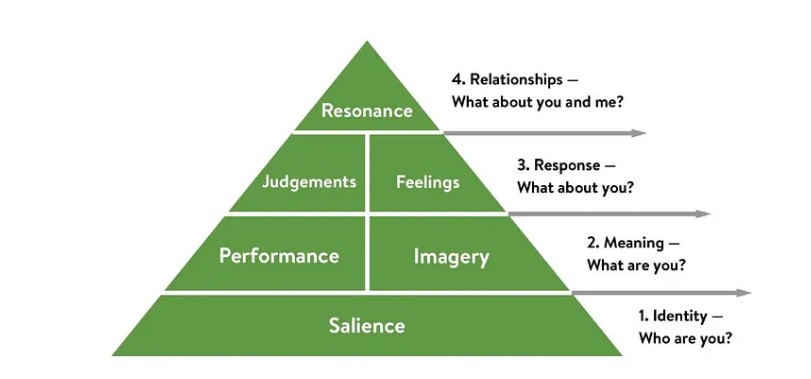Components Of Brand Awareness
There are several vital components to brand awareness.

Building brand awareness (or equity) is a complex process. However, it is required to ensure the long-term success of any business.
This article will look at different brand awareness models to help you understand brand equity and build a stronger brand.
Brand recognition is the ability of consumers to identify a brand when they see it. You can achieve this through solid marketing and a distinctive brand identity.
Brand loyalty is the tendency of consumers to continue purchasing a brand they know and trust. Businesses can build strong brand awareness and create loyal customers by focusing on these critical components: brand recall, preference, and affinity. In addition, it can be built through consistent quality and excellent customer service.
Brand recall is the ability of consumers to remember a brand when they see it. You can improve this through repeated exposure to the brand, such as through advertising.
Brand preference is the tendency of consumers to choose one brand over another. This can be influenced by price, quality, reputation, and marketing factors.
Brand affinity is the emotional connection that consumers feel toward a brand. Brand affinity can be influenced by trust, loyalty, and customer satisfaction.
Brand loyalty is the tendency of consumers to continue purchasing a brand they know and trust.
These factors play a role in brand awareness, and you should consider them when developing a marketing strategy.
The three levels of brand awareness
Brand awareness is often thought of in terms of brand recall, but there are three different levels of brand awareness: Brand Recognition, Brand Recall, and Brand Liking.
- Brand recognition is when consumers identify a brand’s logo or other vital elements. This is the most basic level of brand awareness, and companies must ensure that their branding is distinctive and recognizable.
- Brand recall is when consumers can remember a brand without prompt. This is a higher level of brand awareness, which means that the company has successfully created a memorable brand.
- Brand liking is when consumers have a positive association with a brand. This is the highest level of brand awareness, and it’s what all companies should strive for. You can generate brand liking through positive word-of-mouth, excellent customer service, or a product consumers love.
Creating brand awareness
Creating brand awareness is essential for any company that wants to be successful.
By focusing on all three levels of brand awareness, companies can create a solid and recognizable brand that consumers will fondly remember.
As mentioned before, brand recall refers to the ability of consumers to remember a brand after being exposed to it. On the other hand, brand recognition is the ability of consumers to identify a brand when presented with its name or logo. Brand awareness is a combination of brand recall and recognition.
But for a brand to be truly successful, it must have all three components.
Aaker’s Brand Equity Model
David Aaker created two models for brand equity.
He describes brand equity as an asset made up of positive and negative associations tied to a brand.
Awareness plays a key role in this model. It forms the base. Before anyone can connect meaning, values, or trust to a brand, they need to notice it first.
Aaker outlines four levels of brand awareness:
-
Basic awareness
At this level, the customer simply knows the brand exists. Reaching this point can be difficult, especially for new brands or those in crowded markets. -
Recognition
The customer recognizes the brand when they see it. This often depends on visual elements like logos, icons, or packaging that stand out. -
Recall
The customer remembers the brand without seeing it. This requires strong, consistent exposure and clear associations that stick in memory. -
Association
The customer links the brand to a specific concept or feeling. This only happens when the brand shows up consistently with a clear identity, message, and tone.
Each level builds on the last. A brand must reach awareness before it earns recognition. It must earn recognition before recall. It must achieve recall before a strong brand association takes hold.
If you want to build real brand equity, start with visibility.
Stay clear, stay consistent, and connect your brand to one idea your audience will remember.
Five key elements that contribute to brand equity
Awareness is essential for a brand’s success, but it’s only one piece of the puzzle. Aaker’s model provides a comprehensive framework for understanding and building brand equity.
According to Aaker, five key elements contribute to brand equity: brand awareness, loyalty, perceived quality, and brand association.
Brand awareness refers to the extent to which consumers are familiar with a particular brand.
Brand loyalty refers to the extent to which consumers are loyal to a particular brand.
Perceived quality refers to the extent consumers believe a particular brand is of high quality.
Brand association refers to the extent to which a particular brand is associated with positive attributes.
Patents, IP, and trading partners: brands with higher stocked proprietary rights have a competitive advantage against other brands.
Aaker’s model helps us understand how these elements work together to create brand equity.
What is brand equity?
Brand equity is the value of a brand, determined by the consumer’s perceptions and attitudes toward the brand.
Brand equity is based on the consumer’s past experience with the brand. It includes name recognition, brand loyalty, and positive associations.
Brand awareness is a critical component of brand equity and refers to the consumer’s ability to recognize and remember a brand. Many factors can impact brand awareness, including advertising, word-of-mouth, and association with other brands.
Brand equity is substantial because it can help a brand to differentiate itself from its competitors and to charge a premium price for its products or services.
Brand awareness is also essential for businesses when choosing a brand name, as it can influence the brand’s success in the marketplace.
Measure Brand Awareness with Four Clear Metrics
Brand awareness shows how familiar people are with your brand and what it stands for.
You can measure this through four specific behaviors: recall, recognition, preference, and repeat purchases.
Each one gives insight into how your audience interacts with your brand at different stages.
1. Brand Recall
Brand recall means someone can name your brand from memory when they see a product category. This shows strong brand presence in their mind.
You can test this with unaided recall. Ask people to list brands they associate with a category.
If they mention yours without a prompt, that’s a good sign.
2. Brand Recognition
Brand recognition means people know your brand when they see or hear it. This depends on visual consistency and repetition.
Use an aided recall test. Show a list of brands and ask which ones they recognize.
High scores mean your brand stands out.
3. Brand Preference
Brand preference means people choose your brand over others when given the option. It reflects the strength of your positioning and emotional connection.
Run a preference test. Present brand pairs and ask which one they would buy.
The more people choose your brand, the stronger your place in the market.
4. Repeat Purchase
Repeat purchase means people come back to buy from you again.
This is one of the strongest signs of brand trust.
Use a purchase intent test. Ask how likely someone is to buy again. Track those responses over time to measure loyalty.
These four metrics give you a clear view of brand awareness. When you measure them regularly, you see what works and where to improve.
Use that data to focus your marketing and build a brand people remember and choose.
Use Additional Methods to Measure Brand Awareness
You have more ways to measure brand awareness beyond recall and recognition.
Each method offers a different view of how your brand performs in the market.
Use Surveys
Ask people if they know your brand and how familiar they feel with it. Keep the questions simple and specific.
This works well for tracking awareness in target markets.
Track Google Search Volume
Check how often people search for your brand name. Use Google Trends or keyword tools to compare search volume over time.
Growth in branded searches signals higher awareness.
Monitor Media Mentions
Look at how often your brand appears in articles, blogs, and news. Count mentions in digital and traditional media.
The more people write about your brand, the more visible it becomes.
Watch Social Media
Track brand mentions on platforms like Instagram, LinkedIn, X, and Facebook. Look at comments, tags, and shares.
High activity means your brand is getting attention.
Use Unaided Recall
Ask people to list all the brands they can think of in a product category. This shows how quickly your brand comes to mind. It’s fast to test but depends on memory, so results vary.
Use Aided Recall
Give people a list of brands and ask which ones they recognize. This method works well when you need more reliable data but takes longer to run.
Run Recognition Tasks
Show respondents a set of logos or brand names and ask which one they recognize or associate with a specific idea. This gives precise results but requires more time and budget.
Compare Sales Trends
Look at your sales numbers. Awareness often rises before sales do. If sales increase after a campaign, brand awareness likely improved.
Choose the method that fits your goals and resources. Use a mix of qualitative and quantitative tools.
You’ll get a more complete picture and make better decisions about where to focus your efforts.
Increase Brand Awareness with Clear, Consistent Actions
Brand awareness starts with visibility.
People need to see your brand often and in the right places.
The most direct method is advertising. Run targeted campaigns that show your logo, product, and message to the right audience. Focus on repetition across channels.
You can also show up at trade shows, industry events, or speaking engagements. Visibility grows when your brand appears in relevant spaces.
Use your website, packaging, and social media to reinforce your look and message.
Educate Your Customers
Awareness improves when people understand what you offer. Explain what your product does, who it helps, and why they should choose it.
Clear messaging increases recognition and recall.
Build a Positive Reputation
Strong brands create positive associations. Deliver quality, value, and service. Make sure every customer interaction adds trust.
Reputation spreads faster than ads.
When people expect quality from your brand, they remember it and share it.
Keep Branding Consistent Everywhere
Use the same logo, fonts, tone, and colors across every channel.
Consistency builds familiarity. Make your visuals match on your website, social media, email, packaging, and print materials.
Small shifts in color or tone can confuse customers.
Repetition builds recognition.
Encourage Word-of-Mouth
Word-of-mouth builds credibility.
When customers talk about your brand, it creates trust fast. Offer simple incentives to boost sharing, like referral discounts, giveaways, or exclusive content.
Make it easy for happy customers to recommend you. Ask for reviews. Show testimonials.
Share real feedback.
Use Keller’s CBBE Model to Build Brand Equity
Kevin Lane Keller introduced the Customer-Based Brand Equity (CBBE) model in 1993.
It explains how people build relationships with brands and how those relationships create value. The CBBE model is still one of the most trusted brand frameworks in marketing.
The core idea is simple: brand equity depends on how customers think and feel about your brand. If you want to build value, you need to shape perception.
The model is visualized as a pyramid. You move from basic awareness to deep loyalty.
Each level builds on the one below it.
The CBBE Pyramid: Six Key Components
Keller’s model outlines six building blocks.
These show how people recognize, experience, and connect with your brand.
1. Salience
This is brand awareness. Customers must recognize your brand and recall it in the right context. If they can’t name it or place it, they won’t buy it.
2. Performance
This covers how people evaluate your product or service. They assess quality, reliability, and value. A brand performs well when it meets or exceeds those expectations.
3. Imagery
This is the mental picture people hold about your brand. It includes tone, values, personality, and emotional signals. Imagery forms from design, messaging, packaging, and visuals.
4. Judgments
These are the opinions customers form after interacting with your brand. They judge based on credibility, expertise, relevance, and trust.
5. Feelings
These are the emotions your brand triggers. Keller defines six positive feelings to aim for:
-
Warmth
-
Fun
-
Excitement
-
Security
-
Social approval
-
Self-respect
If your brand can create these emotions, people connect with it faster and more deeply.
6. Resonance
This is the top of the pyramid.
Resonance means customers feel loyal and engaged. They identify with the brand and want to stay close to it.
They recommend it, repurchase often, and defend it publicly.

Why the CBBE Model Matters
The CBBE model gives structure to brand growth.
It shows what to measure, what to fix, and what to focus on at each stage. Whether you launch a new product or strengthen an existing brand, this framework helps you stay aligned with customer perception.
Use it to track how well your brand connects, performs, and grows in customer memory.
Strong brand equity is not built with one campaign. It is built with clarity, consistency, and customer experience over time.
Over to You
Brand awareness is a powerful concept that can majorly impact your marketing efforts, consumer perception, and revenue.
Follow these techniques to establish and build brand awareness.
You’ll find a loyal audience that recognizes your brand among competitors, chooses your products repeatedly, and recommends their friends and family do the same.
Which direction should you take with your visual branding?
Get a very clear overview of your business’s visual identity needs here:
- Group 1- Brand Design 1: How To Brand a Youthful, Open, and Happy Business
- Group 2- Brand Design 2: How To Brand an Elegant, Feminine Business
- Group 3- Brand Design 3: How To Style an Earthy, Community-Focused Business
- Group 4- Brand Design 4: How To Brand a High-End, Luxury Business
Last Updated on 30/05/2025 by Victoria Silber





